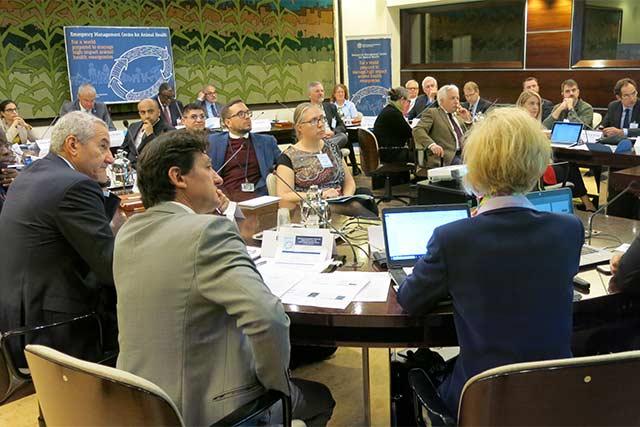
EMC-AH new way of working endorsed
November 27, 2018
The Emergency Management Centre for Animal Health (EMC-AH) Twelfth Steering Committee endorsed the Centre’s new way of working – supporting the implementation of its Strategic Action Plan 2018–2022.
The Steering Committee brought together delegates from over 10 countries and international organizations at FAO headquarters on 8-9 November 2018 to help steer the future of EMC-AH. The 35 participants included senior representatives from Australia, Côte d’Ivoire, European Union, France, Italy, Netherlands, Russian Federation, Saudi Arabia, Sweden, United Kingdom and United States of America. The World Organisation for Animal Health (OIE), the World Health Organization (WHO), INTERPOL, and senior FAO representatives also attended. Dr Junaidu Maina, former Chief Veterinary Officer of Nigeria and current chair of the FAO-OIE Rinderpest Secretariat Joint Advisory Committee, chaired the meeting.
Steering Committee members provided advice on EMC-AH future activities. The discussions led to several recommendations including the strengthening of the EMC-AH platform, developing an outreach strategy, and enhancing awareness of EMC-AH services. The Committee also recommended that EMC-AH serve as the FAO focal point for the United Nations Interagency Standing Committee activation for animal diseases.
Dominique Burgeon, Director of FAO’s Emergency and Rehabilitation Division, opened the session by reminding members that EMC-AH is a joint platform of the Emergency and Rehabilitation, and the Animal Production and Health divisions. He emphasized that the centre is dedicated to improving livelihoods and increasing resilience to animal health-related emergencies and zoonoses by strengthening the application of the emergency management cycle. Mr Burgeon commended the EMC-AH team for publishing the EMC-AH Strategic Action Plan and promptly implementing its related activities.
EMC-AH presented last year’s achievements according to the four components of its Strategic Action Plan: preparedness, rapid response, incident coordination, and collaboration and resource mobilization. Members commended EMC-AH for its new way of working across the spectrum of emergency management, and partners from within and outside of FAO provided positive feedback.
- The representative of the FAO-OIE Rinderpest Secretariat expressed gratitude to EMC-AH for supporting the newly-published Global Rinderpest Action Plan and leading two regional rinderpest table top exercises in Africa (Kenya) and Asia (Sri Lanka).
- FAO representation in South Sudan presented video testimony of EMC-AH supporting Rift Valley fever outbreaks during an ongoing complex and challenging humanitarian emergency.
- Emergency Centre for Transboundary Animal Diseases (ECTAD) recognized EMC-AH's contribution to activities in Asia and Africa. Specific activities highlighted were the EMC-AH coordination with ECTAD for the emergency regional consultative meeting on African swine fever risk reduction and preparedness in East Asia, the tripartite (WHO-FAO-OIE) rapid response mission in Malaysia for rabies outbreaks, the H7N9 preparedness mission to Viet Nam, and the upcoming preparedness workshop on African swine fever in Beijing.
- FAO Fisheries and Aquaculture Division acknowledged EMC-AH's role in Tilapia lake virus training efforts and aquatic emergency responses in Asia.
OIE and WHO, key partners of EMC-AH, emphasized the close collaboration between their organizations. OIE announced an exciting new OIE-FAO-INTERPOL project funded by the Government of Canada to build resilience against agro-terrorism and agro-crime. The joint project with EMC-AH, coupled with the publication of the revised FAO manual on Good Emergency Management Practices, will enhance the centre’s focus on preparedness and better address country-specific needs and significant global risks, including the intentional release of biological agents.
WHO cited EMC-AH’s leading role in activating an FAO Incident Coordination Group for Ebola virus disease in support of the public health response in the Democratic Republic of the Congo. Also highlighted was the project to develop a framework for managing animal health emergency operations centres funded by the United States Defense Threat Reduction Agency. “EMC-AH is a solid point of coordination and contact between FAO, WHO and OIE and allows us to ensure the strongest possible response to acute events,” said Patrick Drury, Manager of the WHO Global Outbreak Alert and Response Network.
Presentations on EMC-AH accomplishments were followed by a series of breakout sessions to discuss challenges and possible solutions with the Strategic Action Plan implementation. Of note was the need for a resource mobilization strategy. Berhe Tekola, Director of FAO’s Animal Production and Health Division, closed the meeting by requesting resource partners to continue to support the EMC-AH’s activities that reduce animal diseases, hunger, and poverty.